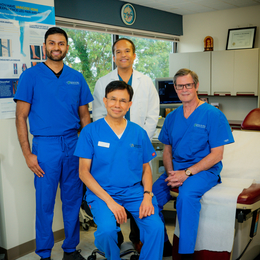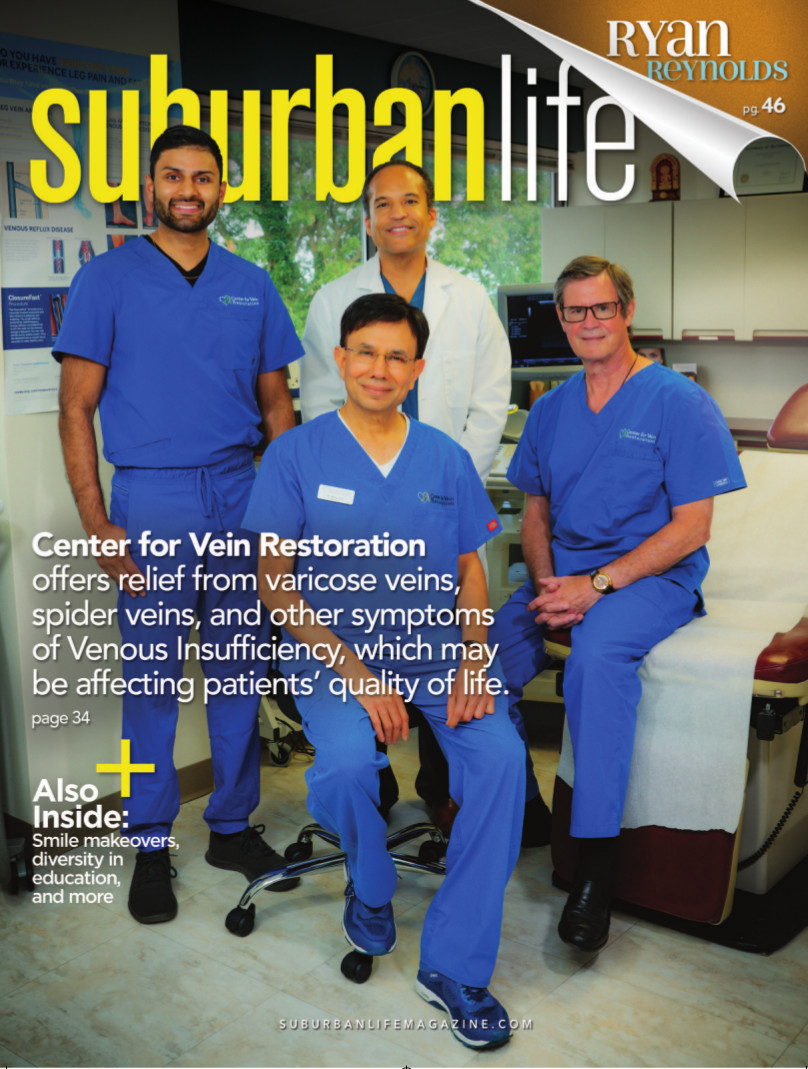
Beneath the Surface
Center for Vein Restoration offers relief from varicose veins, spider veins, and other symptoms of Venous Insufficiency, which may be affecting patients’ quality of life.
Many people dismiss spider veins and varicose veins as purely cosmetic concerns, but this is a common myth, according to board-certified vascular physician Mehul N. Shah, M.D., FSVM. In fact, treatment to address these conditions is typically covered by insurance when medically indicated due to the severity of the symptoms and progression of the disorder. Dr. Shah believes a vast majority of people remain untreated because they assume, wrongly, these veins are a “normal” part of the aging process.
Dr. Shah, who heads the King of Prussia location for Center for Vein Restoration, says spider and varicose veins are symptoms of a disease called Venous Insufficiency. Leaving these veins untreated can lead to symptoms and complications such as leg swelling, skin thickening, skin discoloration, or even leg ulcers and phlebitis. It can also result in leg pain and fatigue, both of which can negatively affect one’s quality of life.
Dr. Shah cites a 75-year-old patient who had run seven marathons—that is, until running became a struggle due to the leg pain caused by Venous Insufficiency. After seeing Dr. Shah, the patient was able to run the Boston Marathon in 2016. He was so pleased with his ability to run the race without pain he gifted Dr. Shah with his marathon medal. This is just one of many, many stories of patient satisfaction Dr. Shah shares with pride from his decades of treatment.
Whereas varicose veins are large and bulging, spider veins are smaller red and purple veins that often twist and turn, resembling a spider’s web. Both warrant attention. Some people assume they must wait until a spider vein becomes bulging before they should seek treatment, but Dr. Shah suggests the visible veins are only the “tip of the iceberg.” Patients with Venous Insufficiency may have blood flow issues only diagnosable only via ultrasound.
The prevailing misconception that these conditions are either normal or purely cosmetic in nature means many patients walk around with them for decades. In fact, an estimated 40 million Americans suffer from Venous Insufficiency.
“Unfortunately, we often don’t see patients until much later in life,” says Michael J. Cornwell, M.D., FACS, who practices at Center for Vein Restoration locations in Bensalem and Horsham. “The downside to that is that it can be more difficult to treat the veins when they have progressed so far. That’s why we encourage people to come in early and then stay on top of the issue.”
Tony Carabasi III, M.D., FACS, a vascular surgeon with Center for Vein Restoration, has been providing high-quality vein care to patients for the past 13 years. He says he is “very pleased” to turn his practice over to Dr. Kas, who he describes as “not only a perfect gentleman but extremely talented in patient care.”
“Dr. Kas” is Abhi Kasinadhuni, M.D., who practices at Center for Vein Restoration’s location in Wayne. He says there’s a spectrum of patients who believe they are either “too young” or “too old” to be treated. In reality, any patient who experiences symptoms is a candidate for treatment. For example, Dr. Kas is currently treating a 22-year-old patient who suffers from leg pain and fatigue. These symptoms have made it difficult for her to complete work tasks, which require her to be on her feet constantly. Simple solutions such as compression stockings are merely a Band-Aid, he says, because the symptoms return as soon as the stockings are taken off. Treatment will ensure her Venous Insufficiency does not get any worse.
The disease is progressive, so even when the veins are successfully treated, new ones can appear or become symptomatic. Some practices treat patients one time, but fail to follow up regularly. This is not the case at Center for Vein Restoration, which stands apart through its commitment to helping each patient stay ahead of the disease.
“A patient’s predisposition to having vein disease is not going to go away, even though we’re treating the veins that are giving them problems,” Dr. Cornwell adds. “We emphasize the importance of ongoing maintenance. A rigorous follow-up protocol is important for ongoing surveillance. Being proactive and treating these problems early will keep patients healthy.”
It is not unusual for the doctors at Center for Vein Restoration to see patients who have already been to other physicians and are still struggling. According to Dr. Kas, “vein disease is underdiagnosed and undertreated.” At Center for Vein Restoration, vein disease is the clinical staff’s primary focus. Whereas a common practice might see a limited number of vein cases a year, Center for Vein Restoration sees thousands.
“Providers who do not exclusively treat veins may only be comfortable with one or two treatment options,” Dr. Kas says. “We utilize a variety of modalities at Center for Vein Restoration—including radiofrequency ablation, endovenous laser ablation, Venaseal, micro-phlebectomy, Varithena, and ultrasound-guided foam sclerotherapy. There is no ‘one size fits all’ approach.”
One of the treatments innovated by Dr. Shah is called Cryo-sclerotherapy, a “virtually painless” modality used to treat cosmetic spider veins. Cryo-sclerotherapy involves a specialized device that blows super-cooled air onto the treatment area, which has a numbing effect, while the physician injects a solution designed to collapse the walls of the targeted small veins. Without the super-cooled air, Dr. Shah suggests patients might say the treatment causes pain that measures a five or a six on a scale of zero to 10 (with 10 being the most pain). With the cold air, that number drops to a one or a two.
“The other advantage to using the cold air is that it makes the vein go into a spasm,” Dr. Shah adds. “So, the medicine I am injecting will not leak out as much, making it more effective. This typically means the patient requires fewer visits. All of that leads to greater patient satisfaction.”
Undoubtedly, patient satisfaction is what it’s all about. Dr. Kas says there’s nothing more rewarding than patients who return after receiving positive results.
“I’ll often hear patients say, ‘I never knew my legs could feel like this,’” he shares. “Or, ‘My legs feel so much lighter.’ The truth is people slowly learn to live with vein disease and don’t realize how debilitating it has become. Until they go through treatment, they don’t even realize just how much their leg pain was holding them back.”
The mission of Center for Vein Restoration locations, throughout Pennsylvania and beyond, is to improve lives in the communities they serve by providing state-of-the-art vascular care in a compassionate and affordable manner. That is the approach to patient care Drs. Shah, Kas, Carabasi, and Cornwell all bring to the practice.
For more information on Center for Vein Restoration, including details on nearby locations in Bensalem, Horsham, King of Prussia, and Wayne, visit centerforvein.com or call 1-800-FIX-LEGS.
Published (and copyrighted) in Suburban Life magazine, November 2020.



